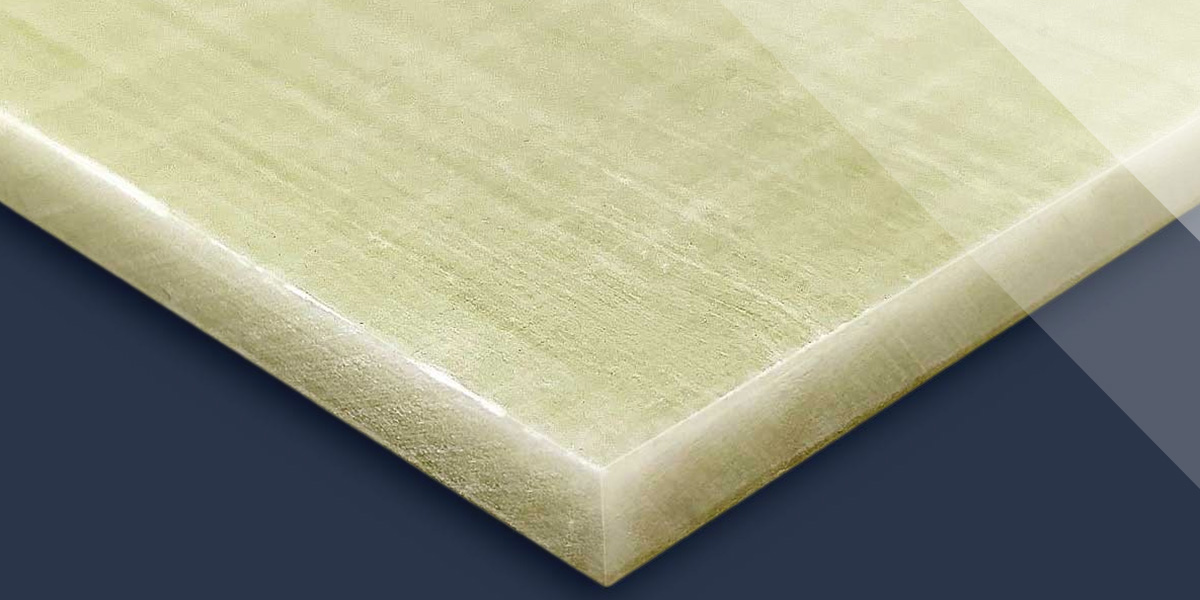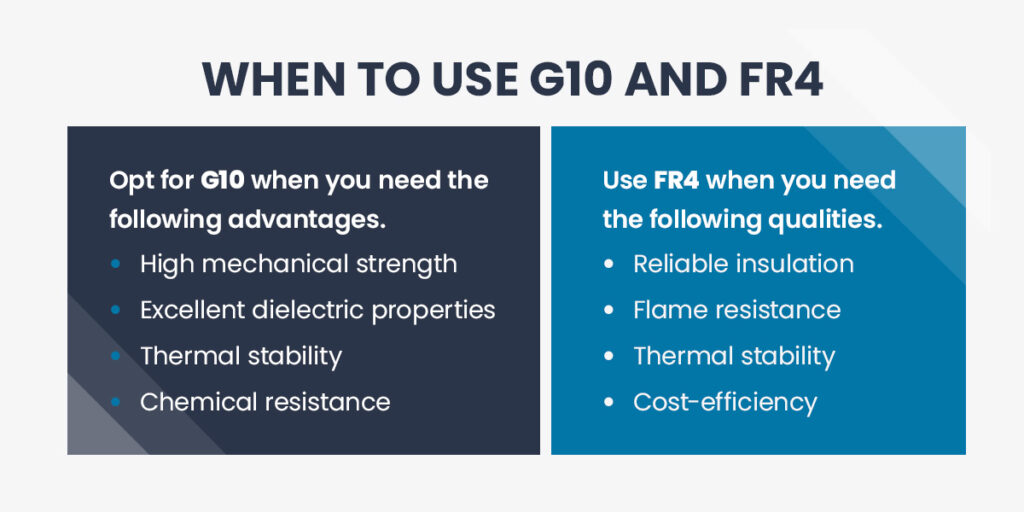
In materials engineering, understanding the critical distinction between G10 and FR4 is paramount. These two composite materials primarily differ in their flame-retardant properties.
G10 material, known for its exceptional electrical insulation and mechanical strength, competes head-to-head with FR4 material, which boasts a higher flame resistance rating. While their mechanical and electrical properties are largely similar, flammability sets them apart.
This article explores the intricate nuances of G10 vs. FR4. We’ll explore their properties, applications, and the scenarios where one surpasses the other. As a competitive player in the OEM, distributor, or fabricator market, understanding these materials is your gateway to unlocking enhanced performance and durability in your electronic ventures.
G10 — The Reinforced Thermoset Composite
G10, a glass epoxy composite, is a versatile, high-performing material with superior mechanical and electrical properties.
G10 Features
To understand the difference between G10 and FR4, exploring G10’s critical features is an excellent starting point.
- High mechanical strength: G10 boasts exceptional mechanical strength, making it ideal for applications requiring materials that can withstand significant stress and strain without deformation. Its resilience ensures components’ durability and longevity.
- Excellent dielectric properties: Among its standout characteristics are its outstanding dielectric properties. G10 exhibits high insulation capability, which is crucial for creating electronic components like printed circuit boards.
- Thermal stability: Glass epoxy sheets can maintain their structural integrity at elevated temperatures. This thermal stability is a game-changer in high-heat applications, as it ensures consistent performance under extreme conditions.
- Chemical resistance: Thanks to its epoxy resin matrix, G10 displays impressive resistance to chemicals, acids, and alkalis. This feature makes it a go-to choice in environments where exposure to corrosive substances is a concern.
G10 Characteristics
G10 is a reinforced thermoset composite material with several distinct characteristics, making it a valuable choice in various applications. These critical attributes contribute to its strength, durability, and suitability for specific industries.
- Glass fiber reinforcement: G10 gets its strength and resilience from its woven glass fiber reinforcement. These fibers allow the material to handle substantial mechanical loads without succumbing to stress.
- Epoxy resin matrix: G10’s epoxy resin matrix is responsible for its excellent dielectric and chemical resistance properties. This matrix binds the glass fibers, creating a robust and versatile composite material.
G10 Applications
G10 is essential in various industries requiring strength, electrical insulation, and resistance to harsh conditions. Here are some of its most notable applications.
- Insulators and bushings: G10’s dielectric properties make it a preferred material for insulators and bushings, which find applications in various industries, including power generation and distribution.
- Knife handles: Its high strength, lightweight nature, and resistance to chemicals and moisture make G10 a sought-after material for crafting durable knife handles.
- Aerospace components: G10’s ability to withstand extreme temperatures, high mechanical loads, and harsh chemicals makes it invaluable in aerospace applications and aircraft components where reliability is non-negotiable.
- Cryogenic Applications: The G10 Epoxy Resin system is more stable at low temperatures and resists cracking at temperatures below 77 Kelvin (-196 Celcius)
FR4 — The Industry-Standard Material
FR-4, also known as glass epoxy or glass-reinforced epoxy, reigns as the undisputed industry-standard material. This material is the cornerstone of modern electronics, offering a blend of properties that meet demanding requirements.
FR4 Features
FR4 offers a range of features and characteristics that make it ideal for various applications.
- Flame resistance: The “FR” in this material’s name stands for “flame retardant.” It complies with the UL standard 94V-0, ensuring it resists the spread of fire, making it a safe electronic choice.
- Electrical insulation: Exceptional electrical insulation is one of FR4’s defining features. It provides a reliable barrier against electrical currents, preventing short circuits and ensuring electronic components operate smoothly.
- Good thermal properties: FR4 exhibits good thermal stability, making it suitable for applications where exposure to elevated temperatures is common.
- Cost-effective: FR4 is a cost-effective choice because manufacturers make large quantities. Made in small batches, G10 is a specialty material. Its affordability and robust features make it a top choice for various electronic applications.
FR4 Characteristics
To further understand FR4, it’s essential to consider its characteristics, which are intrinsic to its composition and structure.
- Woven glass fabric layers: FR4’s strength and durability stem from its woven glass fabric layers composition. These layers provide the material with exceptional mechanical strength, allowing it to withstand mechanical stresses.
- Flame-retardant epoxy resin: At its core, FR4 is a composite material bound together by a flame-retardant epoxy resin. This resin adds to the material’s flame resistance while contributing to its electrical insulation properties.
FR4 Applications
FR4’s features and characteristics make it a suitable choice for various applications.
- Electrical enclosures: FR4 finds use in electrical enclosures and housing due to its electrical insulation and thermal stability. It protects sensitive components from external factors and environmental conditions.
- Automotive components: The automotive sector uses FR4 to make various parts, from engine control modules to infotainment systems. Its ability to withstand heat and vibrations ensures longevity and reliability.
- Consumer electronics: From smartphones to laptops, FR4 is a staple in consumer electronics. Its cost-effectiveness, electrical properties, and flame resistance make it an ideal choice for these devices.
Comparing G10 and FR4 Material Properties
When discerning the difference between G10 and FR4, it’s crucial to consider their material properties, which are pivotal in determining their suitability for specific applications.
- Tensile strength: FR4 and G10 boast a tensile strength of 65,000 psi — excelling in resisting stretching forces.
- Compressive strength: G10 takes the lead with a compressive strength of 40,000 psi, while FR4 follows closely at 38,000 psi.
- Flexural strength: G10 exhibits a higher flexural strength of 75,000 psi compared to FR4’s 60,000 psi, making it more resistant to bending forces.
- Bond strength: G10 holds an edge with a bond strength of 2,200 psi, whereas FR4 offers 2,300 psi.
- Shear strength: G10 boasts a shear strength of 19,000 psi, while FR4 excels with 21,500 psi.
- Hardness, M scale: G10 scores 110 on the M scale, whereas FR4 scores 115.
- Specific gravity: Both materials share a specific gravity of approximately 1.8 to 1.85.
- Flammability rating: FR4, as a flame-retardant material, carries a flammability rating of 94V-0, offering enhanced fire resistance compared to G10, which has a 94HB rating.
- Maximum temperature: FR4 and G10 can endure temperatures up to 284 degrees Fahrenheit.
- Water absorption: G10 demonstrates slightly higher water absorption at 0.11 than FR4’s 0.10.
- Izod impact strength: Both materials showcase an impressive Izod impact strength, with G10 and FR4 registering 14.00 at 120 degrees Fahrenheit.
Understanding these distinctions is instrumental in making informed choices that elevate your products’ performance and reliability.

When to Use G10
G10’s exceptional qualities make it an ideal choice for various applications. Opt for G10 when you need the following advantages.
- High mechanical strength: It withstands substantial stress, making it suitable for gears, bearings, or structural components.
- Excellent dielectric properties: Ensures electrical insulation, preventing short circuits.
- Thermal stability: Maintains dimension under temperature fluctuations.
- Chemical resistance: Ideal for harsh chemical environments, ensuring longevity.
In niche scenarios, G10 shines where bromine content is a concern, particularly in cryogenic applications.
When to Use FR4
FR4, the industry-standard material, offers attributes vital for superior electronic performance and safety. Use FR4 when you need the following qualities.
- Reliable insulation: For isolating electrical components and preventing shorts.
- Flame resistance: It meets UL standard 94V-0 for fire safety.
- Thermal stability: FR4 maintains integrity under temperature variations.
- Cost-efficiency: It balances high performance with affordability.
In most scenarios, FR4 can effectively substitute for G10, meeting all G10 requirements due to its superior flame resistance. However, G10 takes the lead in cryogenic applications, as the presence of bromine molecules in FR4’s BPA epoxy resin can pose potential issues in below-freezing temperatures.

Make the Right Choice — Consult the Experts at Atlas Fibre
In exploring the difference between G10 and FR4, we’ve uncovered the unique properties and applications of these two remarkable materials. While G10 excels in high mechanical strength and dielectric properties, FR4 stands out with its flame resistance and electrical insulation capabilities. The choice between them depends on your specific project’s demands.
Selecting the proper material is a critical decision impacting performance, safety, and cost-effectiveness.
We encourage you to contact the experts at Atlas Fibre, North America’s leading supplier of thermoset composite laminate. With our extensive inventory, rapid response, and advanced technology, we can help you choose the optimal material for your unique needs.
Get a free quote and discover how our expertise can elevate your projects.
